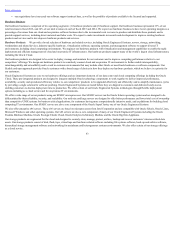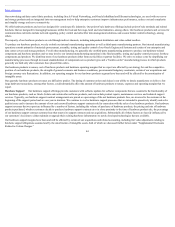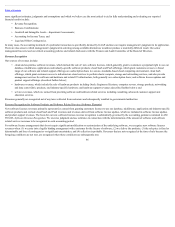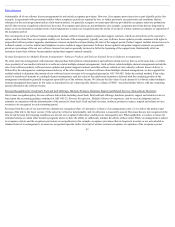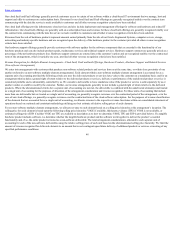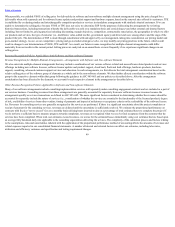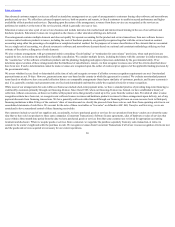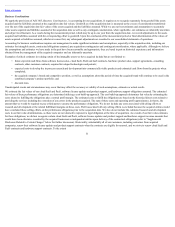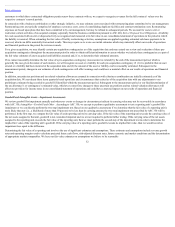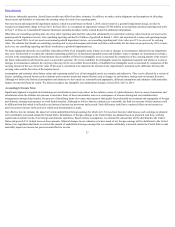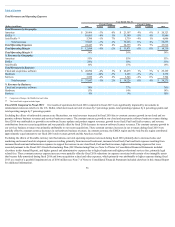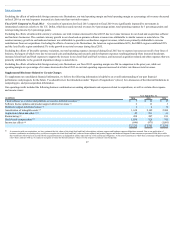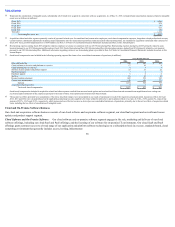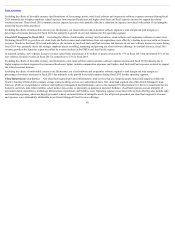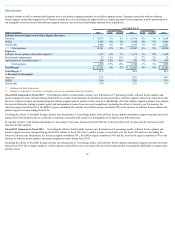Oracle 2015 Annual Report Download - page 55
Download and view the complete annual report
Please find page 55 of the 2015 Oracle annual report below. You can navigate through the pages in the report by either clicking on the pages listed below, or by using the keyword search tool below to find specific information within the annual report.
Table of Contents
but that are inherently uncertain. Actual future results may differ from those estimates. In addition, we make certain judgments and assumptions in allocating
shared assets and liabilities to determine the carrying values for each of our reporting units.
Our most recent annual goodwill impairment analysis, which was performed on March 1, 2016, did not result in a goodwill impairment charge, nor did we
recognize an impairment charge in fiscal 2014. In fiscal 2015, we recognized an impairment charge of $186 million in our hardware products reporting unit (refer
to Note 7 of Notes to Consolidated Financial Statements included elsewhere in this Annual Report for additional information).
Other than our consulting reporting unit, all of our other reporting units had fair values that substantially exceeded their carrying values based on our most recent
annual goodwill impairment review. Our consulting reporting unit had $1.8 billion of goodwill on March 1, 2016, and experienced revenue and operating margin
declines in fiscal 2016. As of our most recent annual goodwill impairment review, our consulting reporting unit’s fair value was 11% in excess of its carrying
value. We estimate that should our consulting reporting unit’s projected margins and related cash flows unfavorably deviate from our projections by 20% or more
each year, our consulting reporting unit likely would incur a goodwill impairment loss.
We make judgments about the recoverability of purchased finite lived intangible assets whenever events or changes in circumstances indicate that an impairment
may exist. Each period we evaluate the estimated remaining useful lives of purchased intangible assets and whether events or changes in circumstances warrant a
revision to the remaining periods of amortization. Recoverability of finite lived intangible assets is measured by comparison of the carrying amount of the asset to
the future undiscounted cash flows the asset is expected to generate. We review indefinite lived intangible assets for impairment annually and whenever events or
changes in circumstances indicate the carrying value may not be recoverable. Recoverability of indefinite lived intangible assets is measured by comparison of the
carrying amount of the asset to its fair value. If the asset is considered to be impaired, the amount of any impairment is measured as the difference between the
carrying value and the fair value of the impaired asset.
Assumptions and estimates about future values and remaining useful lives of our intangible assets are complex and subjective. They can be affected by a variety of
factors, including external factors such as industry and economic trends and internal factors such as changes in our business strategy and our internal forecasts.
Although we believe the historical assumptions and estimates we have made are reasonable and appropriate, different assumptions and estimates could materially
impact our reported financial results. We did not recognize any intangible asset impairment charges in fiscal 2016, 2015 or 2014.
Accounting for Income Taxes
Significant judgment is required in determining our worldwide income tax provision. In the ordinary course of a global business, there are many transactions and
calculations where the ultimate tax outcome is uncertain. Some of these uncertainties arise as a consequence of revenue sharing and cost reimbursement
arrangements among related entities, the process of identifying items of revenues and expenses that qualify for preferential tax treatment and segregation of foreign
and domestic earnings and expenses to avoid double taxation. Although we believe that our estimates are reasonable, the final tax outcome of these matters could
be different from that which is reflected in our historical income tax provisions and accruals. Such differences could have a material effect on our income tax
provision and net income in the period in which such determination is made.
Our effective tax rate includes the impact of certain undistributed foreign earnings for which no U.S. taxes have been provided because such earnings are planned
to be indefinitely reinvested outside the United States. Remittances of foreign earnings to the United States are planned based on projected cash flow, working
capital and investment needs of our foreign and domestic operations. Based on these assumptions, we estimate the amount that will be distributed to the United
States and provide U.S. federal taxes on these amounts. Material changes in our estimates as to how much of our foreign earnings will be distributed to the United
States or tax legislation that limits or restricts the amount of undistributed foreign earnings that we consider indefinitely reinvested outside the United States could
materially impact our income tax provision and effective tax rate.
53


